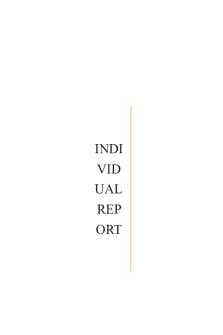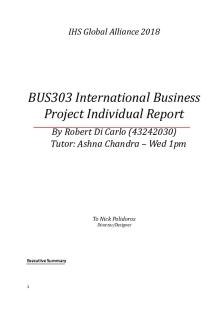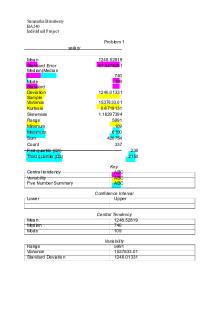Individual Report - 2 PDF

| Title | Individual Report - 2 |
|---|---|
| Course | Marketing |
| Institution | Swinburne University of Technology |
| Pages | 3 |
| File Size | 140.7 KB |
| File Type | |
| Total Downloads | 96 |
| Total Views | 166 |
Summary
Asssiment branding report...
Description
Background Summary Sanitarium, founded in 1898, is a trading name of two sister food companies, the Australia Health and Nutrition Association Ltd and New Zealand Health Association Ltd, owned by the Seventh-Day Adventist Church. The company offers a wide variety of healthy and nutritious breakfast for all to enjoy daily. Weet-Bix - History The Grain Products Limited company first launched WeetBix, which was then acquired by Sanitarium in 1928. In 2018 Weet-Bix celebrated being ninety years as “Australia’s favourite cereal” (Weet-Bix, n.d.) and still continues to hold that name. Market Size The Australian Health and Nutrition Association Limited (AHNA), trading under the name Sanitarium, is well known for its popular Weet-Bix product. IBIS World Industry Reports data shows Sanitarium holds 7.7% of the market share with their industry. Financial Performance The Australian Health and Nutrition Association Limited, who trademarks Sanitarium, is a not-for-profit organisation with an industry-specific revenue expected to grow 2.1% annually over the next five years to about $216.6 million. Although Weet-Bix is a well-known cereal product in Australia, the expanding range of other breakfast cereals has made its popularity hard to maintain. Due to the development of other Weet-Bix products, such as “Weet-Bix Bites, the company has continued to meet consumer demands and remain competitive.
Weet-Bix Marketing Mix Product Weet-Bix, produced by Sanitarium is one of Australia’s most well-known and go to breakfast cereals. According to Sanitarium “Weet-Bix is Australia’s favourite breakfast cereal” (WeetBix, n.d.). The company has created more than just the regular malty flavoured whole grain wheat original Weet-Bix that all Australian’s have loved for many years as now there are different varieties of Weet-Bix to also choose from. The options of ‘Weet-Bix Cholesterol Lowering’, ‘Weet-Bix Gluten-free’, ‘Weet-Bix Organic’, ‘Weet-Bix Blends’, ‘Weet-Bix Bites’, ‘Weet-Bix Little Kids’ and ‘Weet-Bix Protein’, has allowed the company to meet the needs and wants of all Aussies. Although there are many different Weet-Bix types to choose from, the original colours of blue, red and white still are included on all Weet-Bix products, making it stand out to customers as it is easily recognised. Place Weet-Bix can be found in all major Australian supermarkets including Cole, Woolworths and IGA. Promotion The company’s promotional strategies are aimed to specifically target parents with children. Parents always want the best for the children, and with breakfast known as the most important meal of the day, this leaves them with wanting to give their families a healthy and high-quality start to their day. Through the production of commercials and prizes or giveaways, such a family holiday, Sanitarium is able to successfully promote Weet-Bix. The variety of products (previously explored under the ‘Product’ heading of ‘The Four P’s’) Sanitarium offer, indicates how the company aims to cater for all Australia’s both young and elderly. Catering from different needs, shows how the company is putting their customers first, making customers want to continue purchasing their products. Price The price of Weet-Bix across all major supermarkets, including Coles and Woolworths, in Australia remain competitive and are shown to be “budget-friendly”. The product prices differ from size of the box and also the type of Weet-Bix product chosen. At both Coles and Woolworth Supermarkets, a 1.2kg box of Weet-Bix costs $5.00, an 800g box costs $4, a 575g box costs $3.80 and a 375g box costs $2.90. The ‘Weet-Bix Bites’ range (500g) costs $4.65, the ‘Organic Weet-Bix’ (750g) costs $5.65, the ‘Weet-Bix’ Blends (575g) costs $5.30, the ‘Weet-Bix Gluten free’ (375g) costs $5, the ‘Weet-Bix Protein’ (500g) costs $6 and the ‘Weet-Bix Little kids (400g) cost $4.
The Sanitarium company uses the cast-based pricing strategy when pricing their products. This method is based on the cost of production, manufacturing and distribution where a percentage from the manufacturing costs is added to the selling price, leaving them with a profit.
Macro and Micro Factors Micro – competitors Competitors are all the rivalry companies that sell similar products or services. Having efficient and effective marketing strategies, can help a company thrive compared to its competitors. The company Sanitarium, which has a market share of 7.7% in the Cereal, Pasta and Baking Mix Manufacturing in Australia, is shown to have competition with companies including Kellogg’s (market share at 9.8%), and Nestle (market share at 6.7%). In order for Sanitarium to be a successful business, they must produce products of high value and quality that satisfies consumers’ needs and wants in order for them to maintain a competitive advantage. Competition allows companies to continue making new products or improve on existing ones to stand out from its competition. Healthy competition between both Sanitarium and Kellogg’s will provide Sanitarium with the ongoing commitment and drive to produce products that meet consumers' needs and wants, which can allow Sanitarium to grow and stand out in its industry. IBIS World Industry report, states that “Supermarkets are the major downstream market for the industry” (Youl, 2020). From price cutting to heavy discounting on all Cereal, Pasta and Baking Mix products, major supermarkets have constrained the revenue for many manufacturer companies such as Sanitarium. This has forced companies like Sanitarium to modify their product mix in a way which suits the changing consumer dietary and lifestyle means. This goes to show the importance of how meeting consumers wants and needs can allow a business to be successful. Macro- demographic factor Demography is the study of human populations which include factors such as age, gender, location, race, occupation etc. These factors allow businesses to divide their target market into smaller categories known as demographic segmentation, which enables businesses to focus on meeting that specific target group's needs and wants. For example, Sanitarium Weet-Bix’s products are designed to meet a range of ages and life stages seen by the variety of options of different Weet-Bix types for all people to enjoy. From the plain original option, to ‘Gluten-free’ and now even ‘Little Kids’, it shows how all age groups and specific dietary requirements can enjoy the product. Demographic segmentation can also pose risks, as it is based on assumptions and ca...
Similar Free PDFs

Report - Assignment 2 : Individual
- 11 Pages

Individual Report - 2
- 3 Pages

Individual Report
- 14 Pages

ACCG1001 Individual Report
- 6 Pages

BUS303 Individual Project Report
- 23 Pages

Individual Report- Edumondo
- 7 Pages

BA240 Individual Report Brimb
- 6 Pages

Individual Report Walmart
- 7 Pages

Individual Report - Marketing Audit
- 20 Pages

Individual Market View Report
- 7 Pages

Individual Group Report
- 10 Pages
Popular Institutions
- Tinajero National High School - Annex
- Politeknik Caltex Riau
- Yokohama City University
- SGT University
- University of Al-Qadisiyah
- Divine Word College of Vigan
- Techniek College Rotterdam
- Universidade de Santiago
- Universiti Teknologi MARA Cawangan Johor Kampus Pasir Gudang
- Poltekkes Kemenkes Yogyakarta
- Baguio City National High School
- Colegio san marcos
- preparatoria uno
- Centro de Bachillerato Tecnológico Industrial y de Servicios No. 107
- Dalian Maritime University
- Quang Trung Secondary School
- Colegio Tecnológico en Informática
- Corporación Regional de Educación Superior
- Grupo CEDVA
- Dar Al Uloom University
- Centro de Estudios Preuniversitarios de la Universidad Nacional de Ingeniería
- 上智大学
- Aakash International School, Nuna Majara
- San Felipe Neri Catholic School
- Kang Chiao International School - New Taipei City
- Misamis Occidental National High School
- Institución Educativa Escuela Normal Juan Ladrilleros
- Kolehiyo ng Pantukan
- Batanes State College
- Instituto Continental
- Sekolah Menengah Kejuruan Kesehatan Kaltara (Tarakan)
- Colegio de La Inmaculada Concepcion - Cebu




